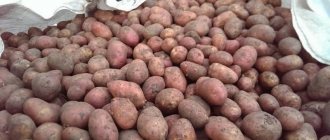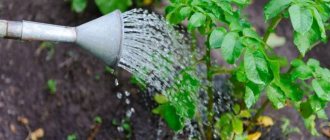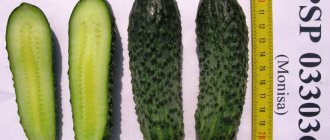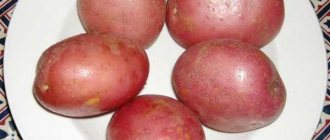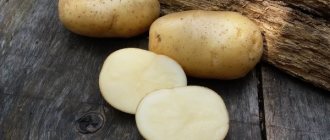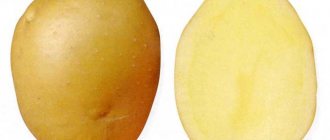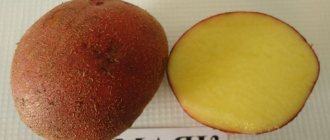On the market you can find many varieties of potatoes for planting. They all have unique characteristics. But due to selective breeding, most varieties lose their productive qualities after several seasons. With each subsequent planting, the fruits become smaller and smaller, and the taste loses its expression. However, there are exceptions. And today’s article is just about such a root vegetable. The hero of the article is the Veneta potato. This is an amazing variety, the description of which will be of interest to many professional agronomists.
Description and characteristics of Vineta potatoes
Vineta potatoes are an extremely early table variety, which was bred using a unique technology. Tubers are characterized by increased transportability and tolerate dry soil and sub-zero temperatures equally well. The potato bush grows up to 70 cm. During flowering, from 4 to 7 large flowers are formed. The root vegetables are relatively small, oval in shape. The color of the peel varies from yellow to light brown. The weight of one tuber reaches 100g. There are no defects such as cracks or green spots. The eyes don't sprout. Starch content is within 15%, and keeping quality is 90%.
Advantages and disadvantages of the variety
The high popularity and demand for the Vineta variety is explained by its unique properties, which not every potato variety can boast of. It has a fairly extensive list of advantages:
- Suitable for growing in regions with unfavorable climatic conditions.
- High consumer qualities - excellent taste, does not get overcooked, and is stored for a long time.
- Early harvest - 65 days after planting.
- Disease resistance.
- 88% of root crops retain their presentation.
- Tubers contain potassium, as well as B vitamins and amino acids.
- The variety is unpretentious in care.
- Uniform ripening of tubers.
- Can grow on any type of soil.
- Resistance to mechanical damage.
This variety has few negative characteristics. Among the disadvantages, we can highlight weak resistance to late blight, as well as to the Colorado potato beetle. It is worth noting that excessive amounts of nitrogen fertilizers have a bad effect on the taste of fruits. Swampy soil leads to the development of late blight.
Reviews from summer residents
Mirnaya Nadezhda Pavlovna, 30 years old, Krasnodar
I have been planting Veneta potatoes in my dacha for more than 5 years. I like the taste, it doesn’t get overcooked, it’s suitable for salads. I'm satisfied with the variety. There is one drawback - it is advisable for gardeners who are not limited by the territory of the site to plant a high-yielding variety. It is necessary to change the planting site after three years. Potatoes degenerate, become smaller and produce fewer tubers.
Skvortsova Olga Vasilievna, 48 years old, Kaluga
I’ve been planting potatoes for a long time, I’ve tried different varieties. There was not a single season when the leaves did not curl. I read reviews about Veneta potatoes. I was attracted by the fact that the culture is disease resistant. This year I tried it and the result was pleasantly surprising. The crop was not sick and bloomed well. The harvest was great. I was satisfied with the taste. I'll see how it stores.
Samoilov Igor Pavlovich, 60 years old, Novgorod region
I am a villager, so I plant potatoes every year. I tried many varieties and settled on “Veneta”. Well kept. Delicious in any form, except raw. Easy to care for. For beginners, advice: does not like nitrogen fertilizing. For those who have not yet started this variety, I recommend it. You will not regret.
Reviews from summer residents about Vineta potatoes are only positive, which is not surprising, given its leading position in the market.
I planted a few Vineta potatoes for a trial and was pleased. I was very pleased with the new potatoes, which were quite large and tasty. Having dug up 2 out of 5 bushes, I received a little more than 1 kg of new potatoes. I dug up the remaining bushes when the potatoes were ripe. I liked it very much. Now I will always grow this variety on my plot and, probably, mainly to obtain young potatoes at the earliest possible date. Alena
We suggest you familiarize yourself with: Domestos for fungus on the walls
I have been planting Vineta potatoes for several years now. I like its unpretentiousness and productivity. The tubers are tasty and crumbly. Great for boiling, frying and stewing. I have never encountered any illness yet. I use my own planting material, growing potatoes from the initially purchased 30 potatoes. The yield corresponds to the characteristics of the potato variety. Anna
I like the Vineta variety, but there are some drawbacks. When digging, difficulties arise due to the fact that the potatoes move a noticeable distance from the bush. I’ve been planting for 3 years now. Inna
Expert opinion
Maria Vlasova
Gardener
Potatoes of the Vineta variety are today recognized as one of the best. Growing it is not difficult, and its taste always remains high. Every year, gardeners are increasingly choosing crops for their plots. Try growing it on your own.
The Vineta potato was obtained by leading German agronomist breeders back in the middle of the last century and within a short time was able to spread across many countries. The value of this variety is its high drought resistance. Therefore, a large number of positive reviews were given by gardeners who cultivate these potatoes in regions with insufficient rainfall.
Veneta potato is a selective table variety, bred in Germany in 1986. Received recognition from European farmers for its high yield, early ripening, and resistance to pests. The variety was brought to the territory of the Russian Federation at the beginning of the 21st century, and in 2001 it was included in the State Register with recommendations for growing tuber crops in the Central, Southern, and Ural regions.
https://www.youtube.com/watch?v=l6G9qi5jSWI
Igor Alexandrovich, 60 years old, Nizhny Novgorod
Veneta is a very good variety for garden growing. What we need first of all is to get our harvest as early as possible in order to enjoy boiled young potatoes. This variety is optimal for this. I plant it already at the beginning of April, having previously warmed the ground under the film, I lay straw on top so that frosts do not damage the plants and then the straw, rotting, provides additional nutrition. Already in June, my grandchildren happily devour young home-made potatoes in oil!
Olga Vitalievna, 42 years old, Pskov region
Our area is clayey, high, and the water is far away. I was tormented by what kind of potatoes I didn’t plant – the small ones grow, the harvests are small. I learned about the Veneta variety three years ago and decided to try it, but without much hope. And in vain! The potatoes were a great success! I really liked that the tubers were smooth, oval, and easy to clean. The downside is that in three years the potatoes have degenerated and become smaller. I will change the seeds this year. And the planting area should also be changed, I think.
Nadezhda, 37 years old, Nakhodka
An interesting potato, not large, stores well, but it must be dug up strictly before the rains begin in our Far East. Otherwise, the tops immediately turn black and dark spots are noticeable on the tubers after digging and drying. It cannot tolerate excess moisture. Otherwise - wonderful tasty potatoes, both in salads and fried. We deep fry it a lot, it turns out dense, in long slices.
Ivan Viktorovich, 57 years old, Moscow region
I have been planting Veneta for 7 years now as a particularly early variety. Never let me down. It always sprouts evenly, grows rapidly, the grass cannot keep up with it, so only one weeding is needed, and it coincides with the second hilling. But I start digging potatoes at the beginning of July, and immediately add ash and rotted manure to the hole and put new potatoes from the old harvest there. I leave it specifically for these purposes. And at the end of September I again have young potatoes, which we eat, but we no longer save them for seeds and storage.
Features of growing crops
As a rule, Vineta potatoes do not cause any difficulties or problems during cultivation. The simplicity of agrotechnical measures is due to its unpretentiousness and resistance to many negative factors. To obtain maximum yield, gardeners should take into account important conditions for growing this variety.
Preparing for landing
Preparatory work begins with germination of tubers. 14 days before sowing, the fruits are placed in a cold and dry place. For germination, medium tubers should be selected whose weight does not exceed 80g. Also, the fruits must have a whole shell. To increase immune protection, planting material must be treated with a weak solution of manganese or copper sulfate. For accelerated growth, the tubers are treated with Epin a day before planting.
See also How to properly apply Corado against the Colorado potato beetle on potatoes
Next, they begin to prepare the site. In the autumn, the soil is leveled, plant residues and any other waste are removed. It is important to do a deep digging of the garden to get rid of pests that hid during the cold weather. After this, the soil is fertilized with mineral and organic fertilizer mixtures. It is important to saturate the soil with minerals. A couple of weeks before planting, add wood ash and dry humus to each hole.
Planting scheme and technology
Potatoes are planted at the end of April. To do this, choose a hill with good lighting, without ravines and away from lowlands where water can accumulate. Good precursors include legumes and mustard. For three years, it is not advisable to plant potatoes where nightshade crops previously grew. Planting technology:
- Tubers with sprouts of about 2 cm are placed in holes whose depth does not exceed 10 cm.
- Carefully sprinkle with soil so as not to damage the sprouts.
- The distance between holes is 40 cm, between beds is 70 cm.
- No watering is required; the soil is loosened and weeds are removed.
It is not recommended to plant the crop in the same place every year, since the nutrients in the soil are depleted over time. If the threat of frost remains, shelters are made for the beds. The first shoots can be expected after 10-14 days.
Correct fit
During planting, follow simple agrotechnical techniques:
- Selection of planting material. It must be healthy, weighing from 35 to 85 g. Treatment of selected tubers with growth stimulants;
- Site selection. It can be a flat surface, well lit by the sun;
- Marking the planting pattern using a string. It is important not to bury the tubers more than 10 cm.
FOR REFERENCE: To improve the composition of the soil, rotted humus or mullein is used.
How to properly care for potatoes
The Vineta variety requires standard agrotechnical measures that are used for growing potatoes.
Watering
The Vineta variety does not require frequent and abundant irrigation. Root crops are saturated as a result of natural precipitation. Potato beds are watered before applying fertilizers, during flowering and tuber formation. In the case of a rainy season, it is necessary to reduce the amount of watering, and in case of severe drought, increase it. You should be guided by the condition of the soil - watering is needed if the soil has dried out more than 8 cm deep. Water is applied strictly under the bush, avoiding dripping on the leaves, otherwise it may cause sunburn. It is not recommended to water almost ripe bushes so as not to harm the crop.
Hilling
Vineta potatoes do not require too frequent hilling - three times before flowering will be enough. Immediately after planting, the potato garden is weeded and weeds are removed. Hilling begins after the first shoots appear. To do this, the soil is raked on both sides. This procedure allows you to protect young shoots from low temperatures, improve soil permeability and enhance the development of the root system of tubers.
Feeding
Throughout its growth and development, the crop will require fertilizing that contains nitrogen, potassium and phosphorus. The first application of fertilizer mixtures is carried out in the spring: the plantings are fertilized with a composition of humus, potassium fertilizers and superphosphate in a ratio of 1:5:6. The first young shoots are treated with ammonium nitrate. To increase productivity, organic solutions of cow manure and poultry droppings are added. It is important to note that plantings should not be processed during the period of flowering and fruit ripening, as this leads to the accumulation of harmful substances in the pulp.
See also Instructions for use of the drug Tanrek for the Colorado potato beetle
Protecting potatoes from diseases and pests
Vineta has a fairly strong immune defense, so it does not need frequent spraying.
However, as with other potato varieties, the greatest threat to this species is the Colorado potato beetle. To combat this pest, the drugs Decis and Fosbecid are used. The product must be diluted in the proportions specified in the instructions and the tops must be treated. In addition, manual collection of pests from bushes is involved. Among folk remedies, it is effective to spray plantings with a urea solution at the rate of 100 g per bucket of water. To prevent the invasion of Colorado potato beetles, onion peels are poured into the holes before planting. Before sowing, preventive treatment of planting material and soil is also carried out. It is recommended to spray the beds with fungicides to ensure better storage of the crop. It would not be a bad idea to treat the beds against rhizoctonia - this way the seedlings will appear at the same time. The Vineta variety is resistant to diseases such as scab, rust, rot, black leg, fusarium, spotting, as well as some other viral and fungal infections. The only thing that potatoes are “afraid of” is leaf blight. To prevent the disease, you need to regularly remove weeds, hill up the bushes and do preventive treatments with Acrobat or Ridomil Gold.
Rules of care
Vineta is considered an unpretentious potato variety, but minimal care is required. It is as follows:
- weeding between rows. It can be done manually or with a walk-behind tractor, which greatly simplifies the process. When weeding, the soil is simultaneously saturated with oxygen, which has a positive effect on future yields;
- hilling. In order for the tubers to form more actively, the tops begin to be hilled. The soil is raked 1-2 times throughout the entire season, this allows you to reduce the frequency of watering;
- watering The crop needs to be watered if the tops wither and there has been no rain for more than 2 weeks.
- insect repellent treatments. Colorado potato beetles pose a danger to potato bushes. The drugs “Decis”, “Acrobat”, “Aktellik”, “Ridomil” will help get rid of them;
Fertilizers can be used only when the crop really needs it. If the soil in the area is clayey and there are few sunny days, then the tops grow weakly, the leaves form inactively, and the bush itself gradually withers. In this case, organic fertilizer based on mullein will help to revive the crop. To prepare it, dilute 1 kg of cow manure with 10 liters of warm water, leave for a day and water the soil with the solution.
The potato crop is harvested from mid-August and later. To understand when the tubers have finally ripened, you need to dig up a couple of bushes for testing. If the fruits in the ground are oval in shape and weigh more than 100 g, then you can dig up the rest. Another sign is fading tops. When the crop finally ripens, the green above-ground part of the plant gradually dries out.
Dig up potatoes in dry weather; the tubers should not get wet. If moisture gets on the surface of the vegetable, its shelf life will be reduced. The dug up fruits are cleaned of any remaining soil, sorted by size, and then put in a warm, dry place to dry. There the fruits are left for several days until the skin becomes hard and the soil remaining on the surface dries out. Then the vegetables are poured into bags or wooden boxes and put into storage at a temperature of 5-10 degrees Celsius.
Note! Potatoes can be stored at home, at room temperature, but only in small quantities (a bucket).
https://youtube.com/watch?v=MTEZRP4iTbQ
Harvest and storage
Harvesting begins after the potatoes are fully ripened, as indicated by the yellowness of the tops. Harvesting is recommended to be carried out at a temperature of no more than 12 degrees - this way you can ensure reliable protection of the tubers from damage. The average yield of the variety is 400 kg. The fruits are harvested 70 days after planting, but young potatoes are dug up after 40 days. The tubers are dried, sorted, and then sent for storage. For this purpose, they are laid out in bags or boxes and placed in a dry place. The storage area should be disinfected: for this use lime or copper sulfate solution.
House slippers or bag
If you have a cat or dog living in your house, then they don’t care what the design of the carpet is. Therefore, give them the unwanted product to use as bedding.
Personally, my cat loves to tear up old carpets. That's why we make scratching posts out of them by wrapping pieces of carpet with the right side inward into wooden boards of different shapes and sizes.
https://www.youtube.com/watch?v=ytadvertise
Often old carpets are in excellent condition and can be used to realize your wildest dreams. Slippers for guests will cost practically nothing, and an original and bright bag will complement the look.


